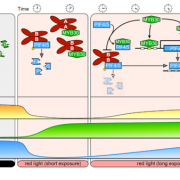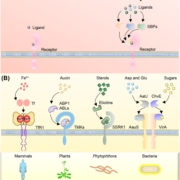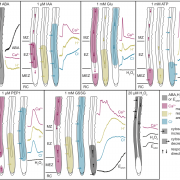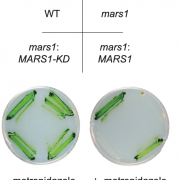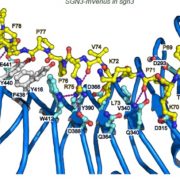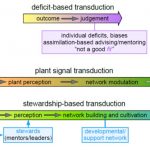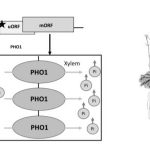Review. Roles of plant retinoblastoma protein: cell cycle and beyond (EMBO J.)
 The cell cycle is at the heart of processes such as cell division, fate acquisition and cell cycle exit towards differentiation. Decades of cell cycle research in animals and yeast have outlined the main components that control the cycle’s transitions, such as cyclins, cyclin-dependent kinases, E2F transcription factors and the Retinoblastoma (RB1) tumor suppressor. Mostly studied in mammalian models, RB1 is a pivotal protein that acts through different complexes to regulate cell cycle transitions at G1/S and G2/M phases. In plants, several lines of research during the mid-1990s led to discovery that the function and modules of core cell cycle regulators, including Retinoblastoma-related (RBR1) proteins, were conserved in plants and unicellular algae, however, new evidence implicates RBR1 in a plethora of novel processes that go past its canonical cell cycle function. A recent review by Desvoyes & Gutierrez describes the multiple roles of RBR1, which acts as a molecular hub coordinating growth, proliferation and differentiation via the formation of multimeric complexes tuned by many regulatory layers, e.g., phosphorylation, ubiquitination, and upstream inhibitors. The authors illustrate that RBR1 interacts with cell lineage-specific transcription factors and chromatin remodeling components through different regions and motifs to modulate several processes, such as cell cycle transcriptional control, cell differentiation in the root apical meristem and the stomatal lineage, as well as embryo and gametophyte development. Moreover, the authors discuss evidence that RBR1 seems to have a role in DNA-damage response and pathogen infection, although a mechanistic view for RBR1 role in these processes is still lacking. This fresh review highlights RBR1 participation in multiple processes and spotlights promising research avenues: how does phosphorylation modulate RBR1 interactions and what complexes might RBR1 be forming with transcriptional factors belonging to other families? (Summary by Jesus Leon @jesussaur) EMBO J. 10.15252/embj.2020105802
The cell cycle is at the heart of processes such as cell division, fate acquisition and cell cycle exit towards differentiation. Decades of cell cycle research in animals and yeast have outlined the main components that control the cycle’s transitions, such as cyclins, cyclin-dependent kinases, E2F transcription factors and the Retinoblastoma (RB1) tumor suppressor. Mostly studied in mammalian models, RB1 is a pivotal protein that acts through different complexes to regulate cell cycle transitions at G1/S and G2/M phases. In plants, several lines of research during the mid-1990s led to discovery that the function and modules of core cell cycle regulators, including Retinoblastoma-related (RBR1) proteins, were conserved in plants and unicellular algae, however, new evidence implicates RBR1 in a plethora of novel processes that go past its canonical cell cycle function. A recent review by Desvoyes & Gutierrez describes the multiple roles of RBR1, which acts as a molecular hub coordinating growth, proliferation and differentiation via the formation of multimeric complexes tuned by many regulatory layers, e.g., phosphorylation, ubiquitination, and upstream inhibitors. The authors illustrate that RBR1 interacts with cell lineage-specific transcription factors and chromatin remodeling components through different regions and motifs to modulate several processes, such as cell cycle transcriptional control, cell differentiation in the root apical meristem and the stomatal lineage, as well as embryo and gametophyte development. Moreover, the authors discuss evidence that RBR1 seems to have a role in DNA-damage response and pathogen infection, although a mechanistic view for RBR1 role in these processes is still lacking. This fresh review highlights RBR1 participation in multiple processes and spotlights promising research avenues: how does phosphorylation modulate RBR1 interactions and what complexes might RBR1 be forming with transcriptional factors belonging to other families? (Summary by Jesus Leon @jesussaur) EMBO J. 10.15252/embj.2020105802


